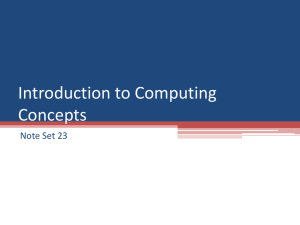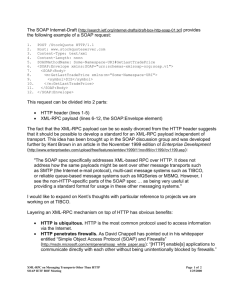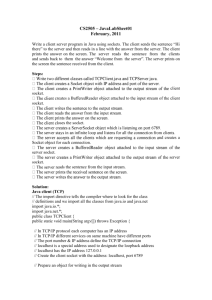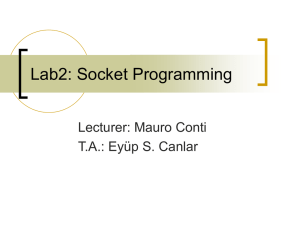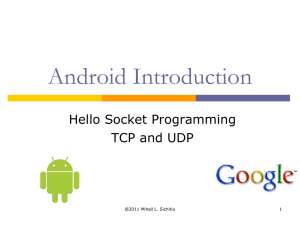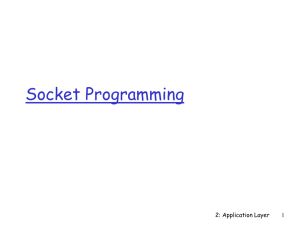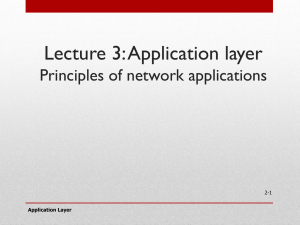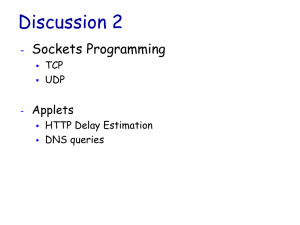Client-server interactions in Mobile Applications
advertisement
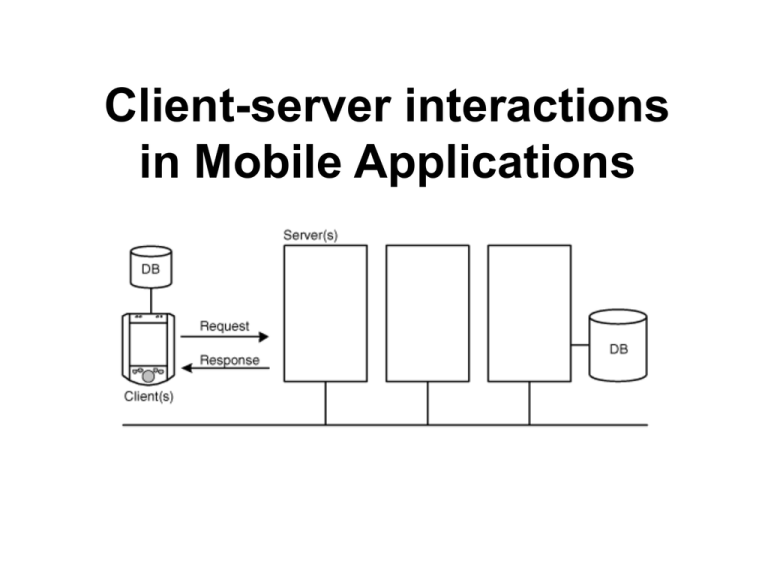
Client-server interactions in Mobile Applications Socket programming with TCP input stream Client Process process output stream outToServer 1) client reads line from standard input (inFromUser stream) , sends to server via socket (outToServer stream) 2) server reads line from socket 3) server converts line to uppercase, sends back to client 4) client reads, prints modified line from socket (inFromServer stream) inFromServer Example client-server app: monitor inFromUser keyboard client TCP clientSocket socket to netw ork input stream TCP socket from netw ork 2 Client/server socket interaction: TCP Server (running on hostid) Client create socket, port=x, for incoming request: welcomeSocket = ServerSocket() TCP wait for incoming connection connection request connectionSocket = welcomeSocket.accept() read request from connectionSocket write reply to connectionSocket close connectionSocket setup create socket, connect to hostid, port=x clientSocket = Socket() send request using clientSocket read reply from clientSocket close clientSocket 3 XML-RPC remote procedure call protocol, created in 1998 specification and a set of implementations, allowing procedure calls over the Internet calls are transported using HTTP, and encoded in XML. simple security model, can authenticate through HTTP/HTTPS Allows one method of serialization Still in use, although newer technologies exist; JSON-RPC, SOAP and others. www.xmlrpc.com Disadvantages XML can be slow and cumbersome in transporting and processing messages Calls can be made with plain XML instead; XML-RPC doesn't add any additional value Implementations: Client: Android XML-RPC Thin, but complete XML-RPC library http://code.google.com/p/an droid-xmlrpc/ Server: Apache XML-RPC Servlet http://ws.apache.org/xmlrpc/ server.html SOAP • Simple Object Access Protol: is a protocol specification for exchanging structured information in the implementation of Web Services in computer networks. SOAP SOAP • Advantage – Allow for the use of different transport protocols (HTTP as a transport protocol, but other protocols such as JMS and SMTP are also usable) – Since the SOAP model tunnels fine in the HTTP get/response model, it can tunnel easily over existing firewalls and proxies. – Can extend the existing infrastructure. • Disadvantage – Since SOAP bases on XML format, it require lots of resource for parsing and processing XML file (especially for large XML file). – SOAP is very verbose, and contains lots of overhead. Not the best choice for data exchange with mobile devices. JSON JavaScript Object Notation – language independent specification of interchanging data in human-readable format. • In contrast with XML-RPC and SOAP it allows for bidirectional communication between client and server (like peers) and for multiple calls. • Data introduced in key:value pair format. • More economical than XML in terms of data size, but has less readability. • Android has JSONArray, JSONObject, JSONStringer and JSONTokener objects for parsing this format. Protocol Buffers Protocol Buffers– language independent data-serialization format developed by Google. This protocol is usually applied in server-to-server interactions. • • • • • Is significant faster and smaller than XML. Type of messages is defined in .proto files. Message is small logical record of a pairs of names and values. Transmitted information is encoded into binary format. Google provide necessary tools for binding this protocol with C++, Java and Python. Comparison of protocols “Using Internet data in Android applications” by Michael Galpin, IBM 2010, http://www.ibm.com/developerworks/opensource/library/xdataAndroid/index.html

